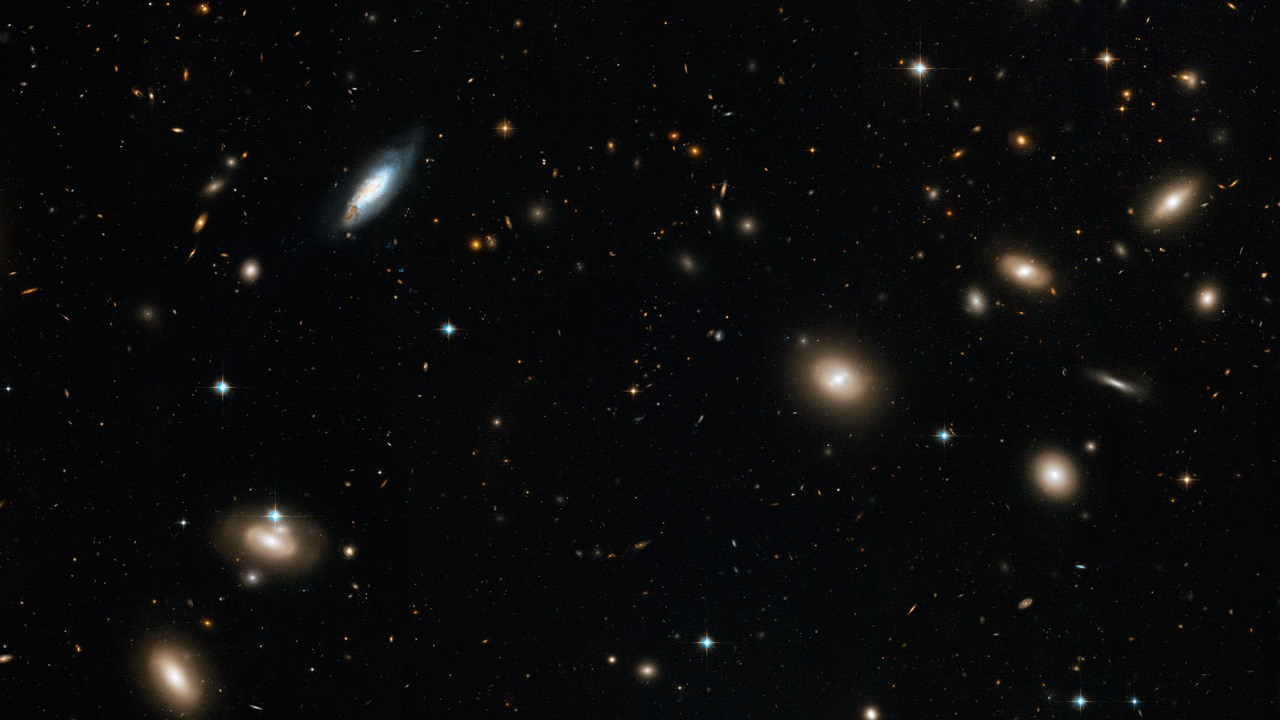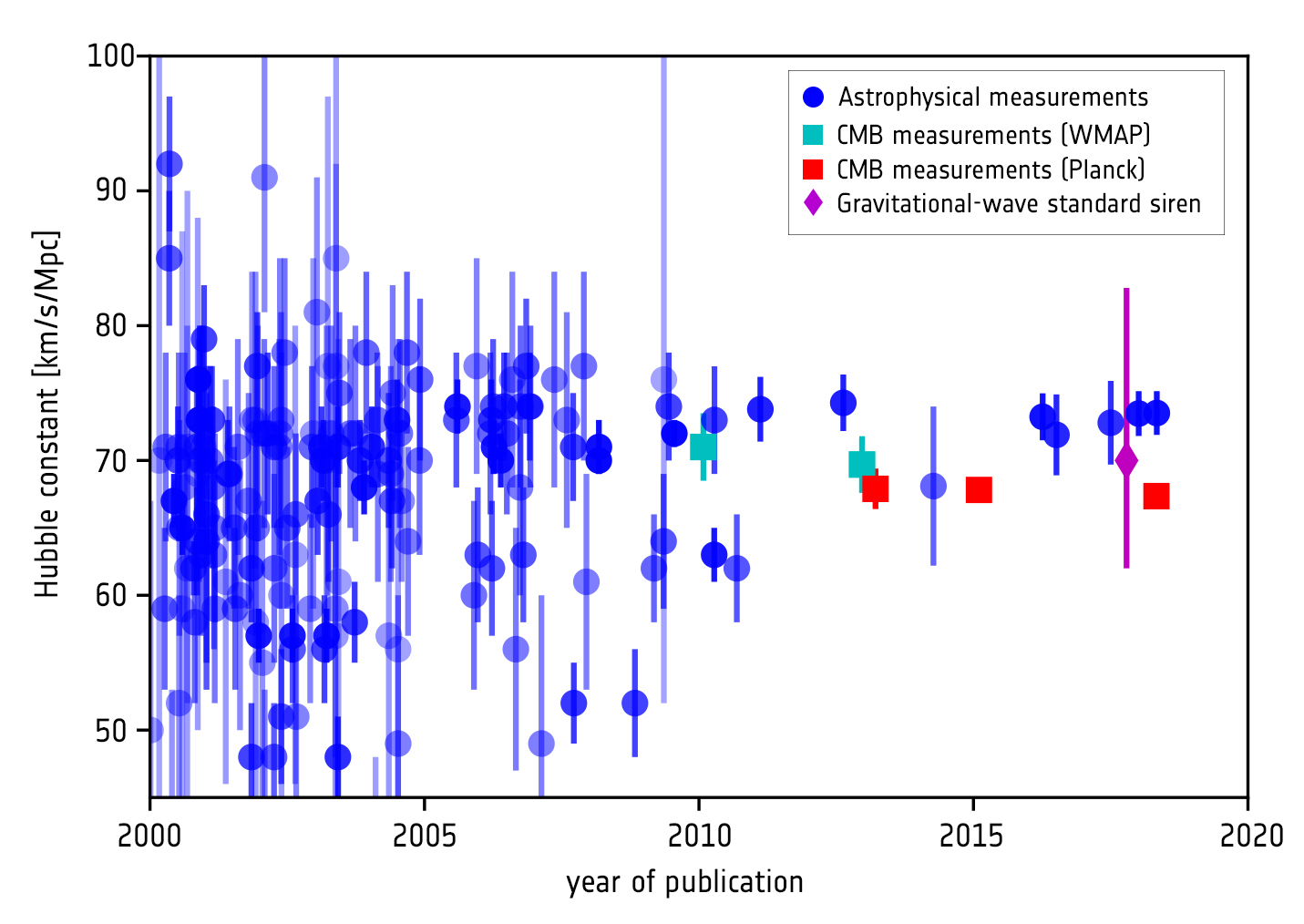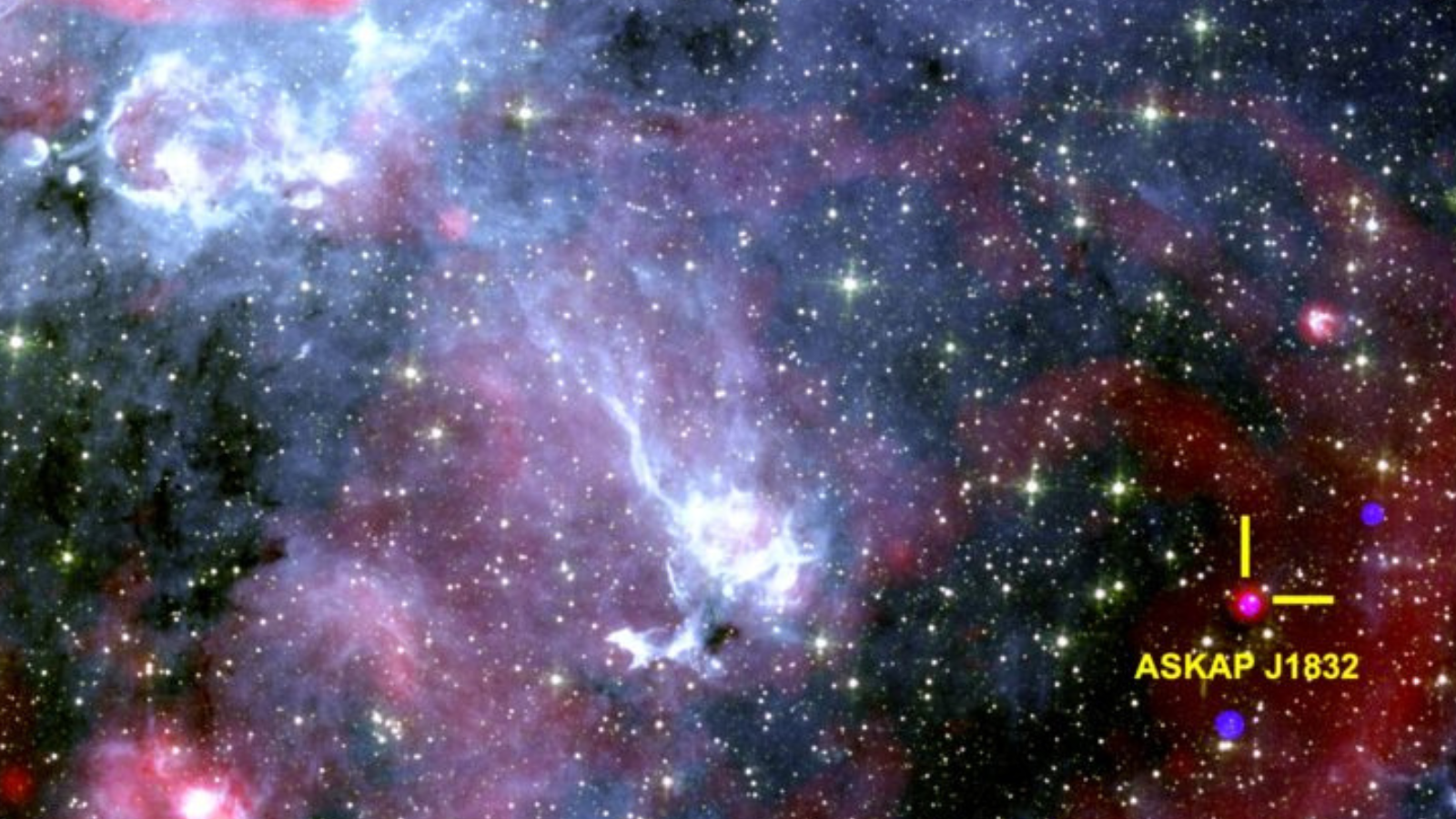Hubble tension is now in our cosmic backyard, sending cosmology into crisis
"The Hubble tension is now a Hubble crisis."

The mystery of the Hubble tension has deepened with the startling finding that the Coma Cluster of galaxies is 38 million light-years closer than it should be.
In recent years, trouble has been brewing in attempts to measure the universe's expansion, which is governed by the Hubble–Lemaître law. This tells us that the velocity at which a galaxy is being carried away from us by the expansion of space is equal to its distance multiplied by the expansion rate, quantified as the Hubble constant. The farther away a galaxy is from us, the faster it is moving away from us.
A team of astronomers led by Dan Scolnic of Duke University in North Carolina and Adam Riess of Johns Hopkins University sought out all type Ia supernova explosions seen by the Hubble Space Telescope in the galaxies of the Coma Cluster of galaxies. Using measurements of these supernovas, the team found that the Coma Cluster is closer to us than the standard model tells us it should be — and that's a big problem.
There's two main tactics for measuring the Hubble constant. One is directly, by observing 'standard candles' — that is, objects with predictable luminosities such as Cepheid variables, type Ia supernova explosions, and red giant stars — in galaxies and determining how far away they are based on the apparent brightness of these standard candles. Coupled with how fast they are moving away from us, which can be derived from measurements of their redshift (which says the faster something is moving away from us, the more its light is stretched into longer, redder wavelengths), astronomers can use the Hubble–Lemaître law to calculate the Hubble constant.
The other tactic is to go back in time, all the way to near the beginning. The cosmic microwave background (CMB) radiation is the light emitted 379,000 years after the Big Bang. Before this time the universe was filled with a dense, seething ocean of plasma, which is ionized gas — it was too hot for electrons and atomic nuclei to combine. The plasma was opaque to light, and density waves reverberated through it.
Then, when the cosmic clock ticked over to 379,000 years, the universe had cooled sufficiently for the electrons and nuclei to combine and form whole atoms. The plasma turned into a fog of neutral hydrogen and helium gas, but those density waves were frozen into the distribution of matter, a distribution that persists to this day, albeit on much larger scales than back then. The CMB captures what those density waves, referred to as 'baryonic acoustic oscillations', or BAOs, looked like 379,000 years after the Big Bang.
Scientists are able to deploy the standard model of cosmology on observations of the CMB to make predictions about the universe. The standard model is our basic picture of a cosmos dominated by cold dark matter and dark energy, operating under the province of Albert Einstein's General Theory of Relativity.
Get the Space.com Newsletter
Breaking space news, the latest updates on rocket launches, skywatching events and more!

Based on observations of the CMB radiation by the European Space Agency's Planck spacecraft, the standard model predicts that the Hubble constant should be 67.4 kilometres per second per megaparsec (km/s/Mpc). A megaparsec is a million parsecs, and one parsec is 3.26 light-years, so in other words what Planck and the standard model predict is that every volume of space a million parsecs across should be expanding by 67.4 kilometers every second.
Yet most measurements of standard candles in the here and now suggest a different value, in the region of 73.2 km/s/Mpc. Both measurements are made to a high degree of accuracy and, according to our understanding of astrophysics and cosmology, both should be correct — but both can't be correct. It has to be one or the other. This unexplained difference is what we call the Hubble tension.
"I like thinking of the Hubble tension as like when you were a kid at the doctor's office, and you got measured when you were a baby, and the doctor might say, well if you're this big when you're young, you'll be this big when you're an adult," Scolnic said at a press conference at the 245th meeting of the American Astronomical Society this January in Maryland.
"In astronomy we can do the same thing with pictures of the cosmic microwave background, which is when the universe was a baby, to predict how big and how fast the universe would be expanding today. And then astronomers like myself can go and measure the expansion of the universe today, and it doesn't match the prediction," Solnic added."
Nobody understands the Hubble tension. When it comes to mysteries of the cosmos, it's almost always near the top of the list. Some scientists think there's some kind of hidden yet persistent error in how we measure standard candles — there's an understandable reluctance to throw out the standard model that has served us so well until now. Yet astronomers who make the standard candle measurements point their finger at the standard model, or at least some unknown phenomenon that the standard model doesn't predict.
Either way, we need to know more, which is why a lot rests on the shoulders of the Dark Energy Spectroscopic Instrument (DESI), based at the Mayall 4-meter telescope at Kitt Peak National Observatory in Arizona.
Beginning its five-year mission to measure the expanding universe in 2021, DESI incorporates 5,000 tiny robotic devices that can position 5,000 optical fibers to collect redshift data from 5,000 objects at a time. Over the course of its five-year survey, it will measure the redshifts of about 30 million galaxies spread across cosmic time to learn how dark energy is accelerating the expansion of the universe.
Uniquely, DESI is able to derive the Hubble constant based on predictions from both the early and late universe. By observing the now scaled-up BAOs in the distribution of galaxies along the cosmic web and comparing them to the angular scale of the BAOs in the CMB, DESI calculates the Hubble constant to be 68.5 km/s/Mpc, very close to the Planck/standard model prediction.
However, DESI's measurements of the Hubble constant in the modern universe, using the brightness of type Ia supernova explosions in galaxies, gives a value of 76 km/s/Mpc — still showing the tension, albeit with a large uncertainty in the measurements.
Astronomers would like to reduce that uncertainty. "The question is, can we help DESI make a better measurement?" asked Scolnic.
So that its results are truly unbiased, DESI builds its own cosmic distance ladder from scratch, rather than relying on previous measurements, with one exception. This is why its observations have a greater uncertainty than previous measurements. That distance ladder needs to be anchored somehow, calibrated with a robust distance measurement to a galaxy or group of galaxies nearby.
To that end, Scolnic and Riess turned to Hubble Space Telescope observations of type Ia supernova explosions in the Coma Cluster of galaxies. "It's a nice, rich cluster with lots of galaxies, and lots of galaxies mean lots of supernovae, and they're all at the same distance," said Scolnic.
This allowed them to calculate a distance of 321 million light-years, give or take an uncertainty of 7 million light-years, to anchor the DESI observations with. This neatly tallies with previous measurements of the distance of the Coma Cluster, but hang on — what does the standard model have to say? It predicts that the Coma Cluster should be 359 million light-years away, but it absolutely is not that far.
"You can see in all those previous measurements, many coming before we even knew there was a Hubble tension, none of them ever came close to what the prediction would be if the standard model was correct," said Scolnic. "They all show that the standard model with the Planck measurement isn't right."
Given that the Coma Cluster is one of the closest galaxy clusters to us, Scolnic describes this finding as being the Hubble tension in our backyard. It should also put to rest the idea that the Hubble tension isn't real, which is an idea that gained traction in the summer of 2024 when a team led by Wendy Freedman of the University of Chicago used James Webb Space Telescope observations of Cepheid variables and red giant stars to measure the distance to 10 galaxies. Freedman's measurements of the Hubble constant based on these ten galaxies were in line with the standard model, suggesting that the Hubble tension may have been a mistake. However, that's a bold conclusion from just 10 galaxies, and Scolnic says that Freedman's result has "now been understood in better context, and the Hubble tension is not gone."
So what could be causing the Hubble tension? Cynics eager to overthrow the scientific establishment might argue that we need to discard the standard model, but it's too early to be throwing the baby out with the bathwater. It's worth remembering that the standard model has had numerous successes, from describing the formation, growth and evolution of galaxies, and the existence of large-scale structure in the universe, to predicting the features of the CMB including the size of the BAOs.
So what could be causing the Hubble tension? Attention is now focused on the early universe and whether there was something there not predicted by the standard model that could have affected the measurements. Perhaps there was an extra burst of dark energy in the early universe, or maybe energy was injected into the early cosmos by radiation from axions, which are theoretical particles and one candidate for the identity of dark matter. It's all still very speculative.
In the meantime the Coma cluster result really hammers home how troubling the Hubble tension is. Indeed, Scolnic thinks that the Coma Cluster findings have irreversibly deepened the mystery, in conclusion stating ominously that "the Hubble tension is now a Hubble crisis."
The Coma Cluster findings have been accepted for publication in The Astrophysical Journal, and a pre-print is available.
Join our Space Forums to keep talking space on the latest missions, night sky and more! And if you have a news tip, correction or comment, let us know at: community@space.com.

Keith Cooper is a freelance science journalist and editor in the United Kingdom, and has a degree in physics and astrophysics from the University of Manchester. He's the author of "The Contact Paradox: Challenging Our Assumptions in the Search for Extraterrestrial Intelligence" (Bloomsbury Sigma, 2020) and has written articles on astronomy, space, physics and astrobiology for a multitude of magazines and websites.
-
Fire-Starter James Has anyone tried Lorentz contracting the redshift based measurements?Reply
Using V(r) = c \00d7 tanh(Hr/c) for Hubble's Law predicts this sort of thing, along with the appearance that the expansion rate is increasing. Besides objects appearing brighter than expected using V(r)=Hr, they should also appear more massive than expected. -
Joshua Zev Levin It seems to me that there is a very simple explanation -- The laws of physics are slowly changing as the universe ages. This is a continuing process. Perhaps they were changing faster when the universe was young, but they are still slowly changing today. It could be simply that physical constants (including the speed of light and the Hubble "constant") are changing, or there could be changes to the more basic laws of Physics.Reply
Nearly 14 years ago, I published a paper "A Common-Plinth Approach to Relativity and Quantum". The Discussion Page is at http://fqxi.org/community/forum/topic/943. To download the full Essay, click on "Download Essay PDF File" on that Discussion Page.
I argue that the universe has nine spatial dimensions organized into three aethers of three dimensions apiece. One of those aethers provides the three spatial dimensions we are familiar with. As these three dimensions expand, the other six contract. I also posit that the laws of Physics depend on the ratios of the sizes of the aethers, and, as the universe ages, these ratios change, and thereby the laws of Physics change. -
RPLEDM This is not a Law. It is an observation and will likely change. Newton, on the other hand, will be here forever, Quantum theory notwithstanding.Reply
Furthermore ,JZL above is on the right track. There are not three dimensions of space but only one, Volume, as points, lines and surfaces do not exist except in our mathematical minds. The four dimensions of space are as Einstein uses in his equation: Energy, mass, time and one part of volume, length. -
m4n8tpr8b To have a perspective on this, it is worth to remember that this is not the first time we have Hubble tension. Throughout the 1990s, the problem was that measurement results were either around 50 or around 100. In the early 2000s, not only did measurement precision improve, but it was found that there were biases in both sets of measurements. This could easily repeat now, instead of us needing completely new physics. It is tough to find a bias with the standard candles nearby, though: there would need to be an effect to make them all brighter with distance/age. (The opposite could be explained by some weak dark matter - photon interaction.)Reply -
Helio I’m happy to put on a dunce hat if someone can explain to me why a slower expansion rate in the past, especially at Recombination, is a problem. It was the discovery of acceleration that gave us DE, so…Reply
What good is acceleration if you never go faster?
The first expansion model (Lemaitre, 1927) showed an increasing expansion rate over time due to the assumed vacuum energy as first noted by Einstein’s cosmological constant.
It was Reiss, however, who was the first to announce DE in 1995(?), and is lead author in the paper, so I’m confident it’s me that’s missing the meat on the tension bones. -
SAE Firstly, as a new replicant let me say Howdy. Secondly, as an art museum professional I've gained the bulk of my cosmological knowledge from 'Starry Night'. I don't fully grasp how a "Coma" cluster can be so tense, but has the concept of launching antidepressants into it been considered? Or making them avaible to cosmologists? I should also state I am not a medical professional.Reply -
Classical Motion The good thing about acceleration that does not go faster is...... eventually you will come to where you started.Reply -
Classical Motion What if the cosmos was in a spin? Instead of an expansion. The shift would have a gradient with distance. Just like we measure.Reply -
Classical Motion Surely by now, the physicists and followers of cosmology, realize that the shift of light is not Doppler.Reply
So what is it? This is fundamental. We can not verify this waveform.
I suggest that the frequency of light is not an alternation of direction or polarity.
I suggest the frequency is presence. An intermittence rate. Blinking.
A duty cycle shift. The ONLY avenue of space propagation. Thru empty space. -
Classical Motion Light would always be seen and measured as incident, but the incidence might be curved. The 13 billion light line is a curve. The curve being undetectable.Reply
And why following light to a star is always the longest route.
And trans warp navigation impossible. We can’t see or measure where anything is.
Curve….. an elongated distance. Doesn’t a curve have a tension? A gradient of distortion.
